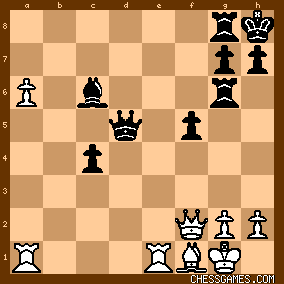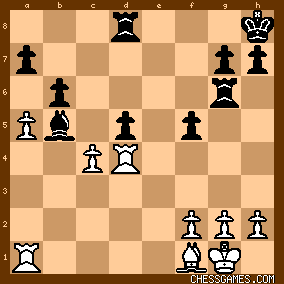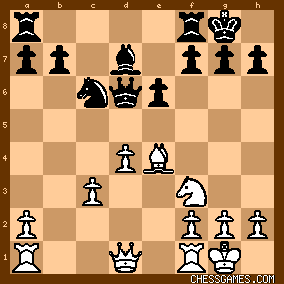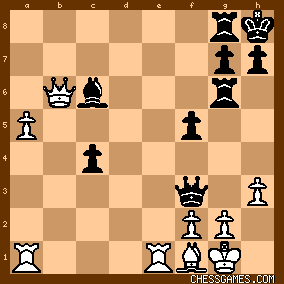| Apr-11-05 | | paladin at large: Fine position play by Tartakower with 17. f5, which drives the white bishop away and opens avenues for black's bishop, queeen and rook to threaten g2. 27. Bc6 is a fine move which maintains the pressure. What's the losing move? White has a series of time wasting moves, e.g. 24. Qb5 25. a5 compounded by 28. Qa6 and 29. Q x a7. It is hard to understand what Alekhine thinks he is doing. |
|
Dec-15-07
 | | chancho: Of the 26 games between these two, Tartakower won 2.(with black pieces)
A well played game by Mr T. |
|
| Dec-15-07 | | whiteshark: <31.h3??> was the final blunder whereas <31.f3!> would have lost only a pawn, e.g. <31...Qxf3 32.Qf2 Qd5 33.a6> with compensation due to ♙a6.

click for larger view |
|
| Dec-15-07 | | whiteshark: After <28.Rxe4 Bxb5 29.Rd4> the position is in balance. 
click for larger view e.g. <29...Bx6 30.cxd5 R6d6 31.axb6 axb6 32.Bc4 g6 <=>>

click for larger view |
|
| Jun-16-09 | | YoungEd: With my usual "I could be wrong" caveat, perhaps 14. c4 was a mistake. The hanging pawns created thereby give Black a target, which force White to trade off his better knight and misplace the queen. Interesting finish. |
|
| Mar-09-14 | | Vogelweide: Fine play by Tartakower.. |
|
| Sep-14-18 | | whiteshark: < YoungEd: With my usual "I could be wrong" caveat, perhaps 14. c4 was a mistake. The hanging pawns created thereby give Black a target, which force White to trade off his better knight and misplace the queen. > An approach:

click for larger view
White to move [Opening Explorer ;) 1) +0.66 (28 ply) 14.Qb1 f5 15.Bd3 b6 16.Re1 Rac8 17.Qb2 Na5 18.Qb4 Qxb4 19.cxb4 Nc4 20.Rac1 b5 21.a4 a6 22.a5 h6 23.h4 Nb2 24.Ne5 Rcd8 25.Be2 Be8 26.Rc2 Na4 27.Nc6 Bxc6 28.Rxc6 Rxd4 29.Rxa6 Rxh4 2) +0.57 (28 ply) 14.Re1 Rac8 15.Qb1 f5 16.Bd3 Na5 17.Qb2 Bc6 18.Ne5 b6 19.Re3 Bb7 20.Rae1 Rf6 21.Rg3 Qc7 22.c4 Rd8 23.Rc1 Nc6 24.Nxc6 Qxc6 25.d5 exd5 26.cxd5 Qd6 27.Bxf5 Bxd5 28.Re1 3) +0.41 (28 ply) 14.Rc1 Rad8 15.Re1 b6 16.c4 f5 17.Bc2 Bc8 18.Bb3 Nxd4 19.Qxd4 Qxd4 20.Nxd4 Rxd4 21.c5 bxc5 22.Rxc5 Bd7 23.Ra5 Ra8 24.Rxf5 a5 25.Rc5 a4 26.Bc4 Kf7 27.Rc7 Kf6 28.Rc5 h6 29.g3 Rd2 30.Rc7 = = = =
compared to the actual move:

click for larger viewBlack to move
1) +0.08 (29 ply) 14...Na5 15.Ne5 Bc6 16.Bc2 b6 17.Re1 Rad8 18.Qd3 g6 19.Rad1 Bb7 20.Bb3 Nc6 21.Nxc6 Qxc6 22.d5 Qc5 23.Re5 a5 24.Qe3 Qxe3 25.Rxe3 exd5 26.cxd5 a4 27.Bc4 Rc8 28.Re7 Rxc4 29.Rxb7 Rc2 30.d6 Rxa2 2) +0.08 (29 ply) 14...b6 15.Re1 Rad8 16.Rc1 f5 17.Bc2 Bc8 18.Bb3 Nxd4 19.Qxd4 Qxd4 20.Nxd4 Rxd4 21.c5 bxc5 22.Rxc5 Kh8 23.Rc7 a6 24.Kf1 Rfd8 25.Bxe6 Bxe6 26.Rxe6 Ra4 27.g3 Rxa2 28.Kg2 h6 29.Re5 Rd1 30.Rxf5 Rb2 31.Rf8+ Kh7 3) +0.21 (28 ply) 14...Rac8 15.Re1 b6 16.Rc1 Ne7 17.Qc2 h6 18.c5 Qc7 19.Ne5 bxc5 20.Nxd7 Qxd7 21.dxc5 Qc7 22.Red1 Rfd8 23.Rxd8+ Rxd8 24.c6 f5 25.Bf3 e5 26.Qb3+ Kf8 27.Qb7 Rc8 28.Rc5 e4 29.Be2 Nxc6 30.Rxf5+ Kg8 31.Bc4+ Kh7 32.Qxc7 all 6.0 minute analysis by Stockfish 9 v010218 |
|
| Jan-27-19 | | YoungEd: Hi, <Whiteshark>:
Thanks for responding--even if it did take you nine years! :) It looks as though I might not have been too wrong, but I wasn't too right either! Again, thanks. |
|
Jun-11-19
 | | Phony Benoni: American Chess Bulletin (May / June 1922, p. 97) adds some moves in the final position:
click for larger view<32.Qxc6 Qxc6 33.a6 Ra8 34.g3 f4 35.Bg2 f3 36.Bf1 Qc5 37.a7 Rxg3+ 38.Kh1 Qxf2> 0-1 Usually, extra moves at the en of a score give a checkmate or other interesting continuation for the reader's benefit. This seems more the deranged ramblings of an angry loser - not like Alekhine at all. Genuine or not, I homer where ACB got it from. |
|
Jun-12-19
 | | Telemus: The game-score in the tournament book ends after 31.. ♕f3. Fiala/Kalendovský agree ("Complete games of Alekhine, vol 2, 1921-1924"). "Nieuwe Rotterdamsche Courant", 15 April 1922 adds 32.♕xc6 ♕xc6, see
https://resolver.kb.nl/resolve?urn=...
This version also appeared in "Casopis Ceskoslovenskych Sachistu" 1922, p 103 where "Deutsche Schachzeitung" was named as source. "Het Vaderland", 18 April 1922 adds the moves that also appeared in the ACB, see https://resolver.kb.nl/resolve?urn=... The earliest source I found during my quick search is "Narodni politika" of 12 April 1922. It does not contain any moves, but it states that Black won this game in 38 moves (however, there is small probability that the 8 is a 3). ---
And I think I considered this case in more detail before, but cannot find my notes. |
|
Jun-12-19
 | | Telemus: Reti commented the game in "Becsi Magyar Ujsag", 16 April 1922, and the game ended there with 31.. ♕f3. |
|
Jun-12-19
 | | Phony Benoni: <Telemus> Thank you. My belief is that the full sequence through move 38 is genuine, simply because it's too ridiculous to have been invented. Proving that is another matter, especially since it does not appear in the tournament book. But you have unearthed enough evidence to show the idea needs to be taken seriously. |
|





































